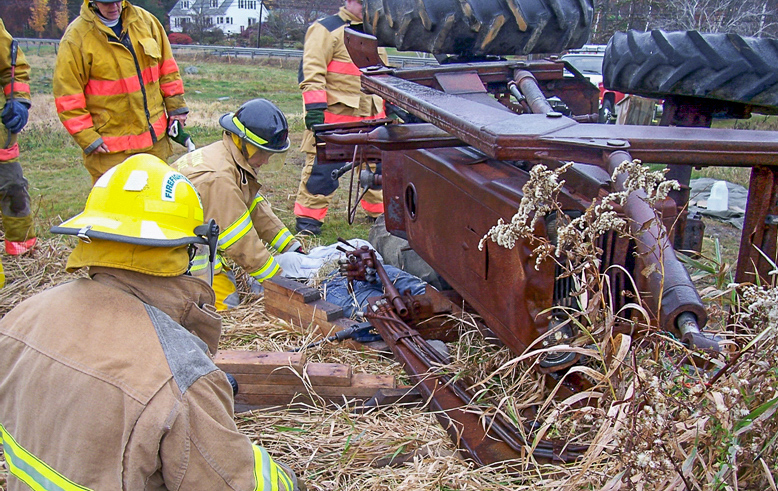Do you know the hazards you might face when dealing with an incident on a farm? Farms, as part of our rural landscapes, can appear to be a working experience that is non-threatening and peaceful.
Used by permission of the Massachusetts Call Volunteer Firefighters Association
by Frederick G, Clark
Deputy Chief, Goshen Fire Dept., Goshen , MA
MCVFA Training Committee
Mass Institute of Fire Dept Instructors (MIFDI)
Photos by Bill Burnett, Ashfield Fire Department
The reality is that next to mining, agriculture has the second highest rate of work related injuries and fatalities in the U. S., according to the National Safety Council. When emergency personnel are called upon to respond to agricultural emergencies, many hazards to their own health may not be immediately obvious to them.
The National Farmedic Training Program was developed by Cornell University to make rescue personnel aware of the unique challenges and dangers they may face when responding to an agricultural incident. Cornell University relates, “It is crucial that rural firefighters, EMTs and other rescue personnel understand where some of the most serious dangers to both farmers and to themselves are located.” From the personnel safety point of view “it is equally important that they know how to safely and effectively respond to these hazards” according to Cornell.

Recently over 30 firefighters, EMTs, and rescue personnel from three counties attended a training session presented by McNeil and Company Insurance Services and sponsored by the Ashfield Fire Department, with assistance of a training grant from MCVFA. The instructor was Lynn Kane, a national certified farmedic instructor from East Schodak, NY.
Issues presented and drilled on were agricultural structures (fire and rescue), agricultural machinery, extrication, and farm chemical hazards.
The program at Ashfield explored hazards in structures, machinery, and chemicals present in agricultural farmsteads and rural enterprises. As someone who has an extensive agricultural and farming background, some of the awareness issues drilled on presented a new perspective to me. The following concepts were discussed and visited by classroom, field trip, and hands on drill experiences:
Agricultural Structures – These present challenges of confined space: silos (vertical, horizontal, and oxygen limiting), grain bins (grain and sawdust bins), elevators for products, barn structures themselves, and manure handling and storage systems. Awareness of structure related agricultural emergencies may seem simple, but complex life threatening situations are often hidden and present a danger to citizens and rescuers alike. Similar structures to grain bins are present in many communities that have breweries, bakeries, concrete plants, and other industries. The drill for rescue from bins was very rewarding and informative.
Agricultural machines present a completely new set of extrication lessons for the first responders. The stability of the equipment is of utmost importance for rescuers and victims alike. Traditional vehicle rescue tools and lifting and blocking apparatus and techniques are often not used in agricultural extrication because of the size, weight, and location of the emergency. Local rescue personnel found that our rural departments did not have some of the basic equipment needed to do the job. Most of all, we did not have adequate blocking immediately available (4” X 4” X 18” hardwood). Rescue air bags were not available locally (only available by mutual-aid at least 20 miles away). Hands-on training with the agricultural machinery was an integral part of the session. Knowing and comprehending what and how the equipment operates is imperative when dealing with entrapments. Practice is important to understanding the special equipment and the rescuer’s safe conduct around it.
Farm Chemicals can involve pesticides, fertilizers, cleaning solutions, and petroleum products present in large quantities on farmsteads and agricultural businesses. Understanding where these chemicals are stored, how to read labels, and accessing and understanding the Material Safety Data Sheets (MSDS) will limit rescuer exposure to these hazards. We were all reminded that these chemicals could be present on the farm as well as in transport to and from the farm on our rural roadways.
The FARMEDIC Class in Ashfield brought these and other safety issues to the forefront in over 20 hours of classroom and hands-on experience. The excellent instructors were exciting and well prepared with subject matter and practical skill presentation. Kudos to all involved for presenting a very informative topic to a regional group of first responders.
I highly recommend this Farmedic class for all first responders in rural regions. For more information, contact the MCVFA Training Committee or the author. You may also visit the National Farmedic Training Program website at www.farmedic.com.
Once again, the students and the Ashfield Fire Department thank the MCVFA for the support and training grant that made this class possible.
